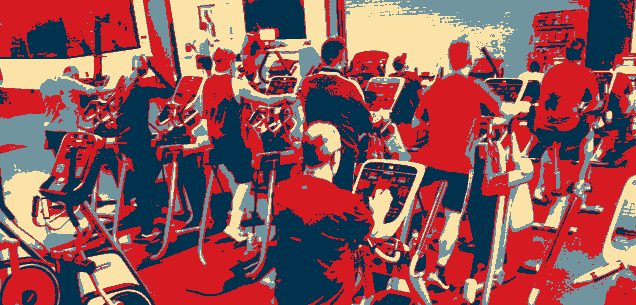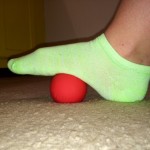 The New Year is one of my favorite times at the gym. Fresh, ambitious faces show up in their bright new workout clothes and fancy new shoes. There are gadgets – arm bands, Garmin watches, weight gloves, and the latest water bottles. Classes are full. The pool has a slight resemblance of a koi pond at feeding time. Getting on a piece of cardio equipment? Maybe in a couple hours. And the weight area, well, that’s a topic for another day. The "natives" look forward to mid-February when all these “resolutioners” get back into their routine of NOT exercising. But I am thoroughly excited and overjoyed by this gym busy-ness! You, the fitness freshmen, who’ve decided that “this is the year I’m finally going to do it”– exercise, that is, or start running or find the weight room or practice yoga or finish a half marathon, are the reason I do what I do. Because this year, a few of you really WILL do it – change your life – and I will joyfully watch, be here to coach, and see you succeed. You’ll fit exercise into your life. You’ll feel better. Sleep better. Get off your blood pressure meds. Have the energy to enjoy your family and run around with your kids or grandkids. Be more productive. I love seeing you succeed, change your life and take care of that beautiful body! As a trainer, I can tell you what you need to do: eat healthfully – lean protein, healthy fats, and lots of colorful fruits and veggies, sleep 7-8 hours a night, move as much as possible, pick up heavy things, and take time for fun. And for most people, this is no surprise. You know what to do. So, how do you get from knowing what to do and actually doing it? Make it a habit.
The New Year is one of my favorite times at the gym. Fresh, ambitious faces show up in their bright new workout clothes and fancy new shoes. There are gadgets – arm bands, Garmin watches, weight gloves, and the latest water bottles. Classes are full. The pool has a slight resemblance of a koi pond at feeding time. Getting on a piece of cardio equipment? Maybe in a couple hours. And the weight area, well, that’s a topic for another day. The "natives" look forward to mid-February when all these “resolutioners” get back into their routine of NOT exercising. But I am thoroughly excited and overjoyed by this gym busy-ness! You, the fitness freshmen, who’ve decided that “this is the year I’m finally going to do it”– exercise, that is, or start running or find the weight room or practice yoga or finish a half marathon, are the reason I do what I do. Because this year, a few of you really WILL do it – change your life – and I will joyfully watch, be here to coach, and see you succeed. You’ll fit exercise into your life. You’ll feel better. Sleep better. Get off your blood pressure meds. Have the energy to enjoy your family and run around with your kids or grandkids. Be more productive. I love seeing you succeed, change your life and take care of that beautiful body! As a trainer, I can tell you what you need to do: eat healthfully – lean protein, healthy fats, and lots of colorful fruits and veggies, sleep 7-8 hours a night, move as much as possible, pick up heavy things, and take time for fun. And for most people, this is no surprise. You know what to do. So, how do you get from knowing what to do and actually doing it? Make it a habit.
Habits: activities that are ingrained into our brains and bodies that take little brain power and energy to complete. Habits do not require willpower. They’re our default when we’re tired and drained. Habits are automatic. They’re controlled by the autopilot of our brain and once it’s in there, it takes energy to stray from the default answer. That’s why changing habits is so hard. I love the example Dr. Christine Carter shares in The Sweet Spot from Jonathan Haidt in The Happiness Hypothesis: A habit is like an elephant with a tiny rider on top. The rider (us) provides direction, but the elephant (the habit) is going to do what it knows: go where it is safe, gets rewarded with food and love, and run from danger. When the rider needs to direct the elephant against its will, it takes a great deal of energy and can be exhausting. To create a new routine for the elephant, the rider must direct the rider with love and reward the elephant for a job well done. To be successful, to live well, we should spend our energy on training the elephant. Make good, healthy choices the default. The habit. Not the constant battle of good and evil.
How do you make exercising regularly a habit? Start small. According to Charles Duhigg in The Power of Habit, it takes time and a little personal research to make a habit. The short of it:
- Identify the behavior you would like to change. Make is a SMALL change to ensure success. (Successful completion of a habit provides positive feelings, a.k.a. automatic rewards - motivators to do it again.) Observe the behavior including what happens before to help you identify a trigger and what happens after – what’s the reward? Last year I was having trouble with my feet. I was training hard with a lot of impact.
 I have strong calves and flat feet and a job where I’m on my feet a lot – a perfect set-up to be plagued with plantar fasciitis. I knew that rolling my feet and calves regularly helps my feet and makes walking out of bed in the morning possible. Training for my Ironman, I needed to make rolling a habit, but the only time I was really doing it was when I felt pain. Que: foot pain Reward: pain relieved; be able to do what I want to do (work/train). Habit I wanted to change: roll my feet every day before I'm in pain.
I have strong calves and flat feet and a job where I’m on my feet a lot – a perfect set-up to be plagued with plantar fasciitis. I knew that rolling my feet and calves regularly helps my feet and makes walking out of bed in the morning possible. Training for my Ironman, I needed to make rolling a habit, but the only time I was really doing it was when I felt pain. Que: foot pain Reward: pain relieved; be able to do what I want to do (work/train). Habit I wanted to change: roll my feet every day before I'm in pain. - Experiment with rewards. Once you determine the behavior you’d like to change, treat yourself like a psychology experiment. What is the reward of the negative behavior that you’d like to change? Social time? A boost in blood sugar? Time away from your desk? A break? Pain relief? Jot down the first few things that come to mind and then come back to that list later and reflect upon your list. Are those truly your rewards? Have you thought of something else? I found identifying the reward was easy – pain relief. But, really, what I wanted to do was to prevent getting the pain so I could effectively complete my training so I could complete the Ironman = reward #2.
- Isolate the cue. What sets the behavior into motion? Where are you when the behaviors occurs? At home, in my bedroom and/dressing area of my bathroom. What’s your emotional state? Disappointed and in pain. Who is around? My family, usually sleeping. What action proceeded the urge? Foot pain. The cue: foot pain
- Have a plan. This is really the kicker. Proactively help yourself so when you’re tired, hungry, and emotionally or energetically weak, you don’t have to think about what you need to do. When I feel ____, I’m going to _____ because it makes me feel _(insert reward)__. When you start to debate why or why not, pause, and remind yourself that you’ve already made a plan and that you’re wasting brain power debating with yourself. For my rolling habit, I decided that I’d roll after I brushed my teeth – a habit that’s already deeply ingrained.
 I put my tennis ball in my bathroom drawer beside my other normal grooming items, so it there was a visual cue to pull it out after I brush my teeth. And, since I brush my teeth twice a day in the same place, it was hard to forget. When I was tired, the plan was set in action: After I brush my teeth, I’m going to roll my feet because it felt good to stretch and relax at the end of the day and made my feet feel healthy. Repeating this behavior over and over made it a habit. I don’t have to think about it now. Of course stuff comes up – I’ll get interrupted during the process and miss the cue (seeing the ball) or have something else to do – and I’ll miss a roll or two, but for the most part, it happens every day without a lot of effort, thought, or willpower required. Oh, and the best part is that I am effectively managing the pain – no drugs or “stop running and jumping” required.
I put my tennis ball in my bathroom drawer beside my other normal grooming items, so it there was a visual cue to pull it out after I brush my teeth. And, since I brush my teeth twice a day in the same place, it was hard to forget. When I was tired, the plan was set in action: After I brush my teeth, I’m going to roll my feet because it felt good to stretch and relax at the end of the day and made my feet feel healthy. Repeating this behavior over and over made it a habit. I don’t have to think about it now. Of course stuff comes up – I’ll get interrupted during the process and miss the cue (seeing the ball) or have something else to do – and I’ll miss a roll or two, but for the most part, it happens every day without a lot of effort, thought, or willpower required. Oh, and the best part is that I am effectively managing the pain – no drugs or “stop running and jumping” required.
This year, why not work towards making that resolution a habit? Start small. Be reflective and mindful of what you’d like to change. Know why. When. Where. And how it happens. Then slowly, forge the path, step by step, making that new behavior a habit. As Dr. Carter puts it “embrace the better-than-nothing plan" when time is short so that the habit continues to build in your brain. Know that something is truly better than nothing. That something is your next step forward.
What are you working on this year? Share your those new habits below!
Want to read more?
- Check out Dr. Christine Carter's website and books, The Sweet Spot and Raising Happiness or Charles Duhigg's The Power of Habit.
- Tips on Finding Time for Health and Fitness
- A Tale of Two Afternoons - How wellness plays a role in overall happiness
- Ready for change - more tips on habit forming
- New Year's Resolutions?
